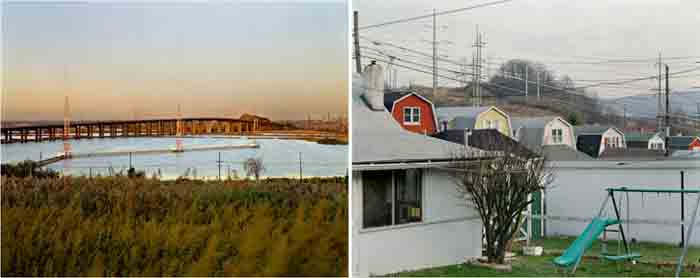Joshua Lutz: Meadowlands
"For most people, the Meadowlands is a place to pass through and forget on their way to someplace else. Not unlike a neglected child, the Meadowlands has grown up without guidance, constantly unsure of what the future holds. It is this loneliness and solitude that continues to bring me back year after year." Joshua Lutz, whose words form the epilogue in his book, Meadowlands, first went there to make photographs ten years ago. A selection of images is currently on view at ClampArt Gallery in Chelsea.
In the days before the TV Sopranos referred to this New Jersey no man's land as the final resting place for anyone misguided enough to mess with them, the 32-square-mile zone already had its share of dark rumors. That Jimmy Hoffa was buried there, chief among them, is the one that originally sparked the photographer's interest.

Left: Untitled 01 (Snake Hill). Right: Untitled 06. Copyright Joshua Lutz, courtesy of ClampArt Gallery.
In the process of recording on film what he saw there, Lutz began to form an emotional connection with the landscape and its inhabitants. On solo scouting trips, he walked and drove its dead-end roads, and narrow lanes so broken down as to have nearly reverted to dirt. Returning with an eight-by-ten camera, he captured the loneliness and isolation he speaks of in scenes where the sun rarely shines; when night is about to come crashing down; or when it seems that a persistent drizzle will never clear away.
Influenced by Stephen Shore, one of his teachers at Bard, Lutz has advanced the New Topographics of his mentor to the post-suburban age. He discovered the soul of a place invisible to those on the turnpike high above, speeding to the airport or to a rock concert. From that vantage point, the Meadowlands offers panoramic vistas of uninhabited marshlands, water treatment plants, junkyards, and industrial warehouses - easily dismissed as a subject for exploration and inquiry.
Lutz has explored and inquired, and in the process has created a claustrophobic, almost choking atmosphere. In a backyard scene, identical houses like a row of sentinels seem to be keeping an eye on the doings across the way. His view of a side yard at dusk, whose satellite dish is monstrously out of scale to the house it serves, provokes a squeamish feeling through the distorted coloration that can result from long exposures. A broad view toward an open waterway is hemmed in by a landfill and a row of scrappy trees. What could be a pristine wetland where birders and kayakers might enjoy an outing is littered with trash as far as the eye can see.
But there is magic here as well. In a late afternoon scene in which a jumbo jet so low in the sky that it's wheels are still down is blurred due to its speed while a massive autumnal willow that frames the scene is etched in precise detail. A red neon sign for the Delayed Cares Motel, whose empty parking spaces suggest it's a destination of no resort, nonetheless beckons the fictional voyager.
Among the people Lutz met in his travels is a white-bearded gardener. Wearing a plaid turban, he proudly maintains chili peppers that grow rampantly out of an unfenced patch of soil in front of a gas station. Denizens of the several motels that capture Lutz's eye invariably project a feeling of detached disinterest in both their surroundings and what goes on there. And a priest in cassock and collar pauses atop Snake Hill, the highest point in the Meadowlands; you have to wonder what he's doing there.
Meadowlands by Joshua Lutz (powerHouse 2008), includes an essay by Robert Sullivan, whose connection with the place began during his childhood. The book's large format, sequencing of images, and exquisite reproduction are a match for the subtlety of Joshua Lutz's photographs. The exhibition continues through October 18th at ClampArt Gallery, 521-531 West 25th Street, NYC. 646-230-0020. Please check the website for information.
101008 meadowlands


